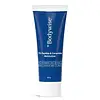What's inside
What's inside
 Key Ingredients
Key Ingredients

 Benefits
Benefits

 Concerns
Concerns

No concerns
 Ingredients Side-by-side
Ingredients Side-by-side

Water
Skin ConditioningShea Butter Ethyl Esters
EmollientGlycerin
HumectantSqualane
EmollientPropanediol
SolventButyrospermum Parkii Butter
Skin ConditioningCaprylic/Capric Triglyceride
MaskingCetyl Alcohol
EmollientStearyl Alcohol
EmollientHydrogenated Vegetable Glycerides
EmollientCetearyl Glucoside
EmulsifyingArachidyl Alcohol
EmollientBetaine
HumectantHydroxyethyl Acrylate/Sodium Acryloyldimethyl Taurate Copolymer
Emulsion StabilisingAlpha-Glucan Oligosaccharide
CleansingPhenoxyethanol
PreservativeXylitylglucoside
HumectantBehenyl Alcohol
EmollientAnhydroxylitol
HumectantTocopheryl Acetate
AntioxidantArachidyl Glucoside
EmulsifyingBrassica Campestris Seed Oil
Skin ConditioningParfum
MaskingXylitol
HumectantAllantoin
Skin ConditioningXanthan Gum
EmulsifyingCitrus Paradisi Fruit Extract
Skin ConditioningCollagen
MoisturisingEthylhexylglycerin
Skin ConditioningOpuntia Ficus-Indica Extract
Skin ConditioningCamelina Sativa Seed Oil
Skin ConditioningLeuconostoc/Radish Root Ferment Filtrate
AntimicrobialBiosaccharide Gum-1
HumectantCitric Acid
BufferingWater, Shea Butter Ethyl Esters, Glycerin, Squalane, Propanediol, Butyrospermum Parkii Butter, Caprylic/Capric Triglyceride, Cetyl Alcohol, Stearyl Alcohol, Hydrogenated Vegetable Glycerides, Cetearyl Glucoside, Arachidyl Alcohol, Betaine, Hydroxyethyl Acrylate/Sodium Acryloyldimethyl Taurate Copolymer, Alpha-Glucan Oligosaccharide, Phenoxyethanol, Xylitylglucoside, Behenyl Alcohol, Anhydroxylitol, Tocopheryl Acetate, Arachidyl Glucoside, Brassica Campestris Seed Oil, Parfum, Xylitol, Allantoin, Xanthan Gum, Citrus Paradisi Fruit Extract, Collagen, Ethylhexylglycerin, Opuntia Ficus-Indica Extract, Camelina Sativa Seed Oil, Leuconostoc/Radish Root Ferment Filtrate, Biosaccharide Gum-1, Citric Acid
Water
Skin ConditioningPropanediol
SolventEthoxydiglycol
HumectantDicaprylyl Carbonate
EmollientCaprylic/Capric Triglyceride
MaskingDimethicone
EmollientArachidyl Alcohol
EmollientBehenyl Alcohol
EmollientArachidyl Glucoside
EmulsifyingCopper Tripeptide-1
Skin ConditioningPanthenol
Skin ConditioningSodium Acrylates Copolymer
Lecithin
EmollientPhenoxyethanol
PreservativeEthylhexylglycerin
Skin ConditioningCeramide NP
Skin ConditioningCeramide AP
Skin ConditioningCeramide EOP
Skin ConditioningPhytosphingosine
Skin ConditioningCholesterol
EmollientSodium Lauroyl Lactylate
EmulsifyingCarbomer
Emulsion StabilisingXanthan Gum
EmulsifyingTocopheryl Acetate
AntioxidantAllantoin
Skin ConditioningHyaluronic Acid
HumectantDisodium EDTA
Water, Propanediol, Ethoxydiglycol, Dicaprylyl Carbonate, Caprylic/Capric Triglyceride, Dimethicone, Arachidyl Alcohol, Behenyl Alcohol, Arachidyl Glucoside, Copper Tripeptide-1, Panthenol, Sodium Acrylates Copolymer, Lecithin, Phenoxyethanol, Ethylhexylglycerin, Ceramide NP, Ceramide AP, Ceramide EOP, Phytosphingosine, Cholesterol, Sodium Lauroyl Lactylate, Carbomer, Xanthan Gum, Tocopheryl Acetate, Allantoin, Hyaluronic Acid, Disodium EDTA
Ingredients Explained
These ingredients are found in both products.
Ingredients higher up in an ingredient list are typically present in a larger amount.
Allantoin is a soothing ingredient known for its protective and moisturizingg properties. Because of this, it is often added to products with strong active ingredients.
Studies show higher concentrations of this ingredient can promote wound healing.
Though it can be derived from the comfrey plant, allantoin is produced synthetically for cosmetic products to ensure purity.
Learn more about AllantoinArachidyl Alcohol is a fatty alcohol made from peanut oil. It is an emollient, emulsifier, and thickener.
You'll most likely find this ingredient as an emulsifier in water-based cosmetics.
We don't have a description for Arachidyl Glucoside yet.
Behenyl Alcohol is a type of fatty alcohol (these are different from the drying, solvent alcohols).
Fatty Alcohols have hydrating properties and are most often used as an emollient or to thicken a product. They are usually derived from natural fats and oils; behenyl alcohol is derived from the fats of vegetable oils.
Emollients help keep your skin soft and hydrated by creating a film that traps moisture in.
In 2000, Behenyl Alcohol was approved by the US as medicine to reduce the duration of cold sores.
Learn more about Behenyl AlcoholThis ingredient is an emollient, solvent, and texture enhancer. It is considered a skin-softener by helping the skin prevent moisture loss.
It helps thicken a product's formula and makes it easier to spread by dissolving clumping compounds.
Caprylic Triglyceride is made by combining glycerin with coconut oil, forming a clear liquid.
While there is an assumption Caprylic Triglyceride can clog pores due to it being derived from coconut oil, there is no research supporting this.
Learn more about Caprylic/Capric TriglycerideEthylhexylglycerin (we can't pronounce this either) is commonly used as a preservative and skin softener. It is derived from glyceryl.
You might see Ethylhexylglycerin often paired with other preservatives such as phenoxyethanol. Ethylhexylglycerin has been found to increase the effectiveness of these other preservatives.
Phenoxyethanol is a preservative that has germicide, antimicrobial, and aromatic properties. Studies show that phenoxyethanol can prevent microbial growth. By itself, it has a scent that is similar to that of a rose.
It's often used in formulations along with Caprylyl Glycol to preserve the shelf life of products.
Propanediol is an all-star ingredient. It softens, hydrates, and smooths the skin.
It’s often used to:
Propanediol is not likely to cause sensitivity and considered safe to use. It is derived from corn or petroleum with a clear color and no scent.
Learn more about PropanediolTocopheryl Acetate is AKA Vitamin E. It is an antioxidant and protects your skin from free radicals. Free radicals damage the skin by breaking down collagen.
One study found using Tocopheryl Acetate with Vitamin C decreased the number of sunburned cells.
Tocopheryl Acetate is commonly found in both skincare and dietary supplements.
Learn more about Tocopheryl AcetateWater. It's the most common cosmetic ingredient of all. You'll usually see it at the top of ingredient lists, meaning that it makes up the largest part of the product.
So why is it so popular? Water most often acts as a solvent - this means that it helps dissolve other ingredients into the formulation.
You'll also recognize water as that liquid we all need to stay alive. If you see this, drink a glass of water. Stay hydrated!
Learn more about WaterXanthan gum is used as a stabilizer and thickener within cosmetic products. It helps give products a sticky, thick feeling - preventing them from being too runny.
On the technical side of things, xanthan gum is a polysaccharide - a combination consisting of multiple sugar molecules bonded together.
Xanthan gum is a pretty common and great ingredient. It is a natural, non-toxic, non-irritating ingredient that is also commonly used in food products.
Learn more about Xanthan Gum